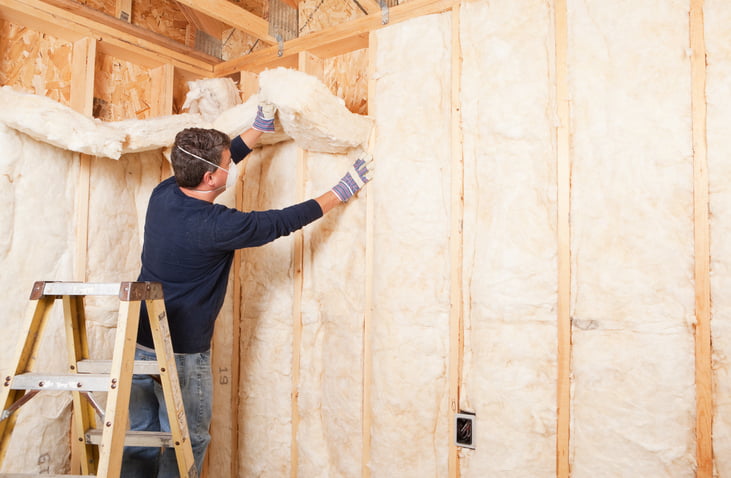Fiberglass insulation is a popular choice for homes and buildings due to its energy efficiency and affordability. But can fiberglass insulation get wet? If so, what will happen next, and what can you do about it?
Whether due to a leaky roof, plumbing issues, or flooding, wet insulation can be more than just a minor inconvenience. While it’s generally effective, one concern that often arises is the possibility of moisture damage. In this article, we will explore the common causes of wet fiberglass insulation, the potential consequences of this issue, and effective solutions to prevent and address it.
Table of Contents:
- What is Fiberglass Insulation?
- Common Causes of Wet Fiberglass Insulation
- Effects and Solutions when Fiberglass Insulation Gets Wet
- Conclusion
What is Fiberglass Insulation?
Fiberglass insulation is made from fine glass fibers and is commonly installed in attics, walls, and floors. It’s known for its ability to trap air, which helps slow down the transfer of heat. This makes it an effective way to regulate a building’s temperature.
The tiny glass fibers in fiberglass insulation create countless air pockets that act as barriers against heat transfer. This insulating ability is measured by the R-value. A higher R-value indicates better insulation. However, moisture can significantly impact the effectiveness of fiberglass insulation.
Common Causes of Wet Fiberglass Insulation
Fiberglass insulation is designed to resist heat flow and maintain a comfortable indoor temperature. However, when it becomes wet, its effectiveness significantly decreases. Understanding the common causes of wet fiberglass insulation can help you prevent issues and minimize damage.
Leaking Roofs
One of the primary causes of wet fiberglass insulation is a leaky roof. Over time, wear and tear, weather conditions, or poor maintenance can lead to cracks or gaps in your roof, allowing water to seep through. This water can easily soak into the insulation below, causing damage and reducing its performance.
Plumbing Issues
Plumbing leaks, such as burst pipes or faulty fittings, can also lead to wet insulation, especially in walls, ceilings, and floors. These leaks can allow water to seep into the insulation, causing moisture buildup and potential damage.
Flooding
Flooding from heavy rains, storms, or rising groundwater can significantly damage fiberglass insulation, particularly in basements and crawl spaces. When water levels rise, it can quickly saturate the insulation, leading to mold growth and reduced efficiency.
Condensation Issues
Condensation occurs when warm, moist air comes into contact with cooler surfaces. This can lead to moisture buildup in areas with poor ventilation, such as attics, basements, or crawl spaces. Over time, this moisture can accumulate in the insulation, reducing its effectiveness.
Poor Ventilation
Lack of proper ventilation in attics, basements, and crawl spaces can trap moisture, creating a damp environment that can lead to wet insulation. Without adequate airflow, moisture has nowhere to escape, promoting mold growth and reducing the insulation’s efficiency.
Poorly Installed Insulation
Improperly installed insulation can create gaps, compression, or uneven distribution, leading to cold spots where condensation forms. These issues can make the insulation more susceptible to moisture intrusion and reduce its effectiveness.
Effects and Solutions when Fiberglass Insulation Gets Wet
When fiberglass insulation becomes wet, it can have several negative consequences. The following table outlines the key effects of wet insulation, along with recommended solutions to address these issues:
| Effect | Description | Solution |
| Absorption of Moisture | Water saturates air pockets in the insulation, reducing its ability to resist heat transfer. | Dry out the insulation: If possible, remove wet insulation and dry it thoroughly before reinstalling. If drying is not possible, consider replacing the insulation. |
| Loss of Insulation Efficiency | R-value decreases, leading to increased energy consumption and discomfort. | Replace the insulation: Wet insulation has significantly reduced insulating properties. Replacing it with dry insulation will restore energy efficiency. |
| Potential for Mold and Mildew Growth | Damp conditions create an ideal environment for mold and mildew, causing health problems and damaging your home. | Remove and replace insulation: Moldy insulation should be removed and replaced to prevent further damage and health risks. Consider using antimicrobial treatments during installation to help deter future mold growth. |
| Structural Damage | Waterlogged insulation can cause wood beams and drywall to rot, weakening the structure. | Repair structural damage: If structural damage has occurred, consult a professional to assess the extent of the damage and develop a repair plan. This may involve replacing damaged wood or drywall. |
| Increased Energy Costs | Ineffective insulation requires heating and cooling systems to work harder, leading to higher energy bills. | Replace insulation: Replacing wet insulation with high-quality insulation will improve energy efficiency and reduce energy costs. Consider upgrading to a higher R-value insulation for even greater savings. |
Conclusion
Wet fiberglass insulation can have significant consequences, including reduced energy efficiency, potential health hazards, and structural damage. By understanding the common causes of wet insulation and taking proactive steps to prevent and address moisture issues, you can protect your home’s insulation and maintain its effectiveness.
If you suspect your insulation may be wet or damaged, it’s essential to take action promptly. Contact Ener-Spray for a professional inspection and assessment. Our experts can help you identify the source of moisture, remove and replace damaged insulation, and implement preventive measures to prevent future problems.
